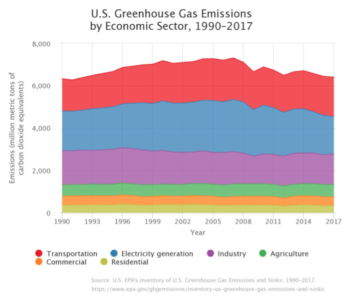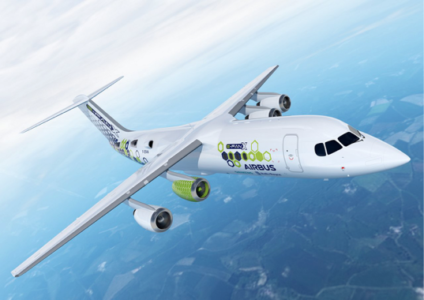by Christine Skolnik
Last week, Professor George Crabtree presented Deep Decarbonization, a talk about new and emerging energy technologies within the context of climate change. The talk was organized by 350 Chicago and hosted by the DePaul University Institute for Nature & Culture. George Crabtree is a Distinguished Professor of Physics at the University of Illinois at Chicago and Director of the Joint Center for Energy Storage Research at Argonne National Laboratory. The talk included a brief review of some vitally important points related to climate change, a discussion of various current technology issues, as well as research and development challenges for the future. The talk is available on the 350 Chicago website. https://world.350.org/chicago/2019/10/07/deep-decarbonization-an-evening-with-professor-george-crabtree/
I was particularly interested in Dr. Crabtree’s discussion of business and industrial challenges. While most people, including knowledgeable activists, tend to focus on issues related to consumer uses of energy, Crabtree explained the real research and development challenges lay in business and industrial sectors. In this short article I’ll review some of the introductory points that bear repeating. I’ll then focus on the stated need for research and development in business and industry.
In 1986, Swedish scientist, Svante Arrhenius proposed that increases in CO2 would cause global warming. “Cutting-edge nineteenth-century science,” Crabtree commented. Because human beings largely ignored, discounted, or avoided this trend for over 100 years, we now face an increasing number and increasing severity of natural disasters. (Warmer air and water temperatures cause severe storms to develop faster and last longer, for example.) The table below illustrates that the cost of natural disasters between 2014 and 2018 was double the long-term average.
https://www.climate.gov/news-features/blogs/beyond-data/2018s-billion-dollar-disasters-context
While we continue to debate the very existence of anthropogenic climate change (in the U.S.), rather than focusing on developing new energy generation, storage, and saving technologies, we are straying farther and farther from the strongly recommended path of a less than 2° global rise in temperature.
Dr. Crabtree also described four possible future tipping points that would increase global warming, and which are not generally factored into current models. 1. Melting of the polar ice sheets will reduce reflectivity at the poles and thus increase the temperature of oceans everywhere. 2. The thermohaline current, which regulates ocean temperatures and transfers CO2 from shallow to deep water, will likely change as a result of changes at the poles, causing significant changes in ocean temperatures and terrestrial climates. 3. Melting permafrost could release millions of tons of methane, a greenhouse gas, and significantly accelerate global warming. 4. Acidification of the oceans will result in increased CO2 from the shells of dead marine organisms and a reduction in photosynthesizing plankton that remove CO2. One effect of these changes could be a sea level rise by 2050 that would affect 150 million people. https://www.washingtonpost.com/climate-environment/2019/10/29/scientists-triple-their-estimates-number-people-threatened-by-rising-seas/
Still Americans remain skeptical or uninformed. In 2018 only 17% of Americans understood that the issue of climate change is settled science. A significant portion of the American public (36%) believed that the number of scientists who believe that climate change is caused by human factors is between 51% and 90%. An astonishing 24% of Americans believe that only half of climate scientists or fewer attribute global warming to anthropogenic factors. (Of those surveyed, 21% said they didn’t know.) This public perception problem is obviously a serious barrier to policy changes that would support necessary research and development.
The Paris Climate Accord, adopted in 2015, identified a critical outcome in addressing climate change. Increases in global temperatures must remain below 2°. This goal would require 100% decarbonization by the year 2050: a complete halt on carbon emissions as well as the development of technologies to remove carbon from the atmosphere. Since Paris, the focus of the international community has shifted to what Dr. Crabtree described as “the last 50%” of the carbon dioxide reduction challenge. Generally speaking, the first 50% of the problem can be addressed by alternative energy production for consumer energy needs, and the use of electric cars fueled by alternative energy sources. Many business and industrial processes, however, present unique challenges.
An EPA inventory of U.S. greenhouse gas emissions between 1990 and 2017 described emissions by sector. Each major sector emitted over a billion metric tons of “carbon dioxide equivalents” every year. Transportation was responsible for 29% of emissions; electricity generation responsible for 28%; and industry was responsible for 22% of GHG emissions. (The remaining sectors were agriculture, commercial, and residential.)
https://cfpub.epa.gov/ghgdata/inventoryexplorer/#allsectors/allgas/econsect/all
Unfortunately, the energy needs of commercial transportation and industrial manufacturing cannot be addressed by the same solutions we have developed for private transportation and residential energy consumption (*Editors note at the bottom of this post). Amazon will introduce 100,000 electric vans for local deliveries between 2021 and 2024, but long-haul trucks are not yet electric due to current limitations in range and charging times. Long haul trucks have to travel great distances, obviously, and such large batteries would take a great deal of time to charge. Hydrogen fuel cells are a potential alternative to current battery technology for heavy, long-range trucks. Hydrogen batteries are quite safe and create no GHG emissions. However, it is still quite expensive to produce hydrogen as a fuel.
Another transportation-related problem is commercial flights. There are quite a few prototypes of small electric planes. However, these have not yet been scaled up for commercial use. Airbus is developing a large, hybrid plane with one electric engine (out of four), but this will not get us to 100% decarbonization by 2050.
https://www.airbus.com/newsroom/news/en/2018/07/the-future-is-electric.html
The major alternative energy challenge in commercial flight lays primarily in getting planes up to a cruising altitude. This seemed like a significant obstacle, but Dr. Crabtree observed the dramatic progress made by the airplane industry in the first half of the twentieth century.
Industrial manufacturing was the other primary topic of discussion. We know plastic is a problem before it enters and after it exists industrial processes, because it begins with fossil fuels and ends up in our oceans. However, I was surprised to learn there is currently no method for producing steel with alternative energy sources. Upon reflection this makes sense. We all know that steel is forged at extremely high temperatures (about 1000 degrees Celsius). What I did not know is that high temperatures like this can only be produced by combustion. Hydrogen is an alternative combustion fuel, but it is currently most efficiently produced from natural gas and coal gasification. As an expert in materials science, Dr. Crabtree emphasized the need for research and development into alternative manufacturing processes and materials.
Other areas where Dr. Crabtree recommended research and development were artificial photosynthesis, utility- and grid-scale electrical grid improvements, and new materials for battery storage. Specifically, he mentioned the recent adoption of big batteries by utilities and graphene as a new material for efficient and low-cost battery storage.
The bottom line is this. To remain below a 2° increase in global warming, we have to invest a great deal of research and development into replacing “the last 50%” of dirty energy. Crabtree said we have to brainpower, but insufficient funding. He ended his talk by advocating for a carbon tax as a logical way of reducing carbon emissions and funding research.
The talk was followed by a lengthy question and answer period. Though I don’t have space to cover audience questions here, I’d like to draw our readers’ attention to the “USE IT” act, mentioned by a member of the audience. USE IT is a proposed act of Congress which supports carbon capture research but is clearly designed to support the fossil fuel industry and give them further license to extract and burn carbon-based fuels. The audience member noted that Illinois Senator Tammy Duckworth is co-sponsoring the bill. This is clearly a subject of concern for all Americans and should prompt an organized response from Chicagoans. See more information at the U.S. Senate Committee on Environment and Public Works website.
—
*Editors note by Kyle Burkybile
In the last week alone, a breakthrough advancement in AI technology has given hope to some the biggest industrial challenges that Professor Crabtree raised in his talk. A startup backed by Bill Gates has shown it is able to reach temperatures of 1000 degrees Celsius via concentrated solar power, which would eliminate the need to use fossil fuels when those temperatures are required.
When combined with this innovative process that could result in emissions-free concrete production, there is much reason for much optimism in the coming years that we could decarbonize the industrial sector.
We are getting closer to having all the necessary tech advancements needed to transition our global economy to one based on 100% renewable energy. All that remains is to collectively find the will to actually make it happen.






